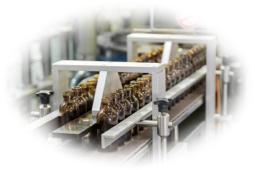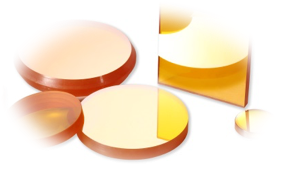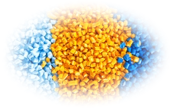 載入中...請稍候...
載入中...請稍候...訂閱電子報
- 首頁
- SE & TE
SE & TE

SOURCES OF SELENIUM AND TELLURIUM
Se and Te are rare elements almost never found in the native state. Tellurium was discovered in 1782 by an Austrian chemist, Von Reichenstein, while examining gold ore from Transylvania. Selenium was discovered in 1817 by a Swedish chemistry professor, Berzelius. They are widely dispersed in the earth's crust at average levels less abundant than silver. They rank 69th and 75th, respectively, in order of abundance. There are no ores from which Se can be mined as a primary product. It is found principally in sulfide minerals of copper iron, and lead and is most common in chalcopyrite, bornite and pyrite. It occurs most abundantly in the North American porphyry copper deposits of the western U.S., and in the copper-nickel and copper-zinc ores of central and eastern Canada. Se values also occur in copper ores in Africa, Asia, Europe, South America, Oceania and Australia. Occasionally it is found in conjunction with native sulfur and in the form of selenites of other metals. Te rarely occurs in the native state, usually being associated with gold, silver, copper, lead, mercury and bismuth ores. One of the most common tellurium minerals is sylvanite, a complex gold-silver telluride. Extraction of Se and Te from ore is a complex process involving numerous hydro- and pyro-metallurgical treatments. Flotation concentrates are smelted to remove sulfur, iron and other impurities. Treatment of 200 tons of copper ore typically yields one pound of Se. Treatment of 500 tons of copper ore typically yields one pound of Te. Se and Te are undesirable impurities in copper. Separation takes place in the electrolytic copper refinery where impure Cu anodes are dissolved by electrolysis and redeposited as high purity copper cathodes. The impurities dissolve in the electrolyte or settle as slimes to the bottom of the cells. Present in the slimes as selenides and tellurides of copper, gold, and silver, Se and Te are separated by various processes, and are further refined into commercial product forms and compounds. Both Se and Te are ecomically recoverable from industrial scrap and chemical process residues. For example, worn out and damaged photoreceptor drums are returned to manufacturers for recycling, where the Se-Te alloy is stripped off and shipped to refineries for separation and purification. An estimated 15% of refined selenium production comes from secondary sources.
APPLICATIONS FOR SELENIUM
MAJOR APPLICATIONS FOR SELENIUM
The first commercial application for Se was found during World War 1, as a substitute for critically short manganese, a decolorizer in glass making. A wide variety of industrial applications have since been developed. Average annual usage is currently estimated at 1850 metric tons.
Electrolytic Manganese:
40% of demand. Used in the production of Electrolytic Manganese as a current efficiency enhancer.
|
Glass: 25% of demand. Selenium decolorizes the green tint caused by iron impurities in glass bottles; produces the ruby red color in art glass; reduces solar heat transmission through architectural glass. |
 |
 |
Agricultural/Biological: 10% of total demand. An essential element to life, Se is added in trace amounts to animal feeds, veterinary preparations, and boluses to prevent certain diseases in animals and increase growth. Soil deficiencies are corrected by adding selenium to chemical fertilizers. In medicine, Se compounds act as a fungicide to control dandruff and dermatitis, and as a human diet supplement for control of certain diseases. |
|
Electrical: 5% of demand. High purity selenium and selenium alloys were used in photoreceptors for plain paper copiers and laser printers. Today Selenium is used in rectifiers and voltage surge protection devices; CO 2 laser windows, infrared detectors, Laser optics, photovoltaic cells, x-ray receptors for medical imaging. |
 |
 |
Pigments: 5% of demand, Cd sulfoselenide compounds are highly stable pigments used in plastics, ceramics, glazes and paints, for products which during manufacturing or use are subjected to moisture, high temperature, ultraviolet or chemical exposure. Se in pigments can produce a wide variety of colors as diverse as red, orange and maroon. |
Metallurgy:
5% of demand. Selenium addition improves machineability of carbon steel, stainless steel, copper, and acts as a grain refiner in the grids of low-maintenance lead-acid batteries.
Other Applications:
5% of total demand. Used as a component in catalysts for selective oxidation; in plating solutions to improve appearance, antiquing effects, and durability; blasting caps; gun bluing;
MAJOR APPLICATIONS FOR TELLURIUM
|
Solar 40%. Used with Cadmium to product Cadmium Telluride Alloy, which is used in the production of Photo Voltaic Thin film Solar panels. Cadmium Telluride PV is the first and only thin film photovoltaic technology to surpass crystalline silicon PV in cheapness for a significant portion of the PV market. |
 |
Thermo-electric Modules (TEM)
30%. Tellurium is used in an alloy that is used in these TEMs. A TEM is a semiconductor-based electronic component that functions as a small heat pump. By applying a low voltage DC power source to a TE module, heat will be moved through the module from one side to the other. Therefore, one side will be cooled while the opposite side will be heated. Consequently, a TE module can be used for both heating and cooling.
Metallurgy - 15%
15%. Used as an additive in steel as an internal lubricant to increase the machineability.
 |
Rubber Applications 5%. Used to produce a rubber vulcanizing accelerator. |
Others - 10%
COMPOUNDS COMMERCIALLY AVAILABLE
Selenium Metal, Alloys & Compounds
Selenium metal, commercial grade (99.5% min. Se)
Selenium metal, high purity (99.999% Se)
Selenium-Antimony Alloys,
Selenium-Arsenic Alloys
Selenium-Tellurium Alloys,
Selenium Dioxide,
Selenious Acid,
Barium Selenate,
Barium Selenite
Bismuth Selenide,
Calcium Selenite,
Copper Selenide,
Ferro Selenium,
Potassium Selenate
Sodium Biselenite,
Sodium Selenate,
Sodium Selenite,
Zinc Selenide,
Zinc Selenite
Tellurium Metal, Alloys & Compounds
Tellurium metal, commercial grade (99.5% min. Te)
Tellurium metal, high purity (99.99%-99.9999% Te)
Tellurium-Manganese Alloys,
Bismuth-Tellurium Alloys
Copper-Tellurium Alloys,
Ferro Tellurium
Tellurium Dioxide,
Telluric Acid